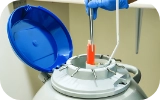What Is the Endometrial Receptivity Array (ERA) Test?

The amount of emotional stress and anxiety that a couple goes through while undergoing fertility treatment is inexplicable. No couple wants to go through the dilemma of repeated implantation failure or RIF. Modern technologies such as endometrial receptivity array (ERA) offer new hope to couples coping with implantation failure.
Tests like ERA can be a ray of hope for those couples who are finding it difficult to conceive even after 3 attempts of in vitro fertilisation (IVF) treatment, for example. Keep reading to learn about what ERA is, its benefits, test procedures, and much more.
What is ERA?
In the field of fertility treatment, the term ERA stands for Endometrial Receptivity Array or Endometrial Receptivity Analysis. It is a genetic test in which a small sample of a woman's endometrial tissue is taken to assess if her endometrial lining is properly developed such that it can successfully accept an implanting embryo.
What Is the ERA Test?
In the field of fertility treatment, the term ERA stands for endometrial receptivity array or endometrial receptivity analysis. It is a genetic test in which a small sample of a woman's endometrial tissue is taken to assess if her endometrial lining is properly developed such that it can successfully accept an embryo for implantation. Despite that, every patient who is taking IVF treatment may not find the endometrial receptivity array test helpful. Nonetheless, the ERA procedure for IVF can be helpful in tailoring the treatment to optimise the chances of conception for a patient. ERA test may also be recommended for some patients who are undergoing IUI treatment.
Why Is ERA Done?
In simple terms, the endometrial receptivity array test is done to determine the optimal window of implantation (WOI) for a patient undergoing IVF treatment.
Generally, doctors use ultrasound to determine the endometrial thickness to monitor the progress of the treatment and prepare for embryo transfer. Despite this, there have been cases in which the patient experienced multiple IVF failures even after having an optimum endometrial thickness and a healthy, high-quality embryo transferred into their womb. This may occur due to the variations in their WOI, which may cause the WOI to occur earlier or later than expected. The endometrial receptivity array test is helpful for such cases.
How Does the ERA Test Work?
ERA, which is done using the latest scientific technology, analyses the expression of 248 genes per sample with the objective of determining the optimal time window for planting the embryo into a woman's uterus. This promotes a successful embryo implantation and, in turn, a successful pregnancy in women undertaking infertility treatments.
The menstrual cycle of each woman has a WOI or a small window of optimal time during which her uterine lining reaches the perfect state for implantation. This window lasts for a few days, typically from the 19th day to the 23rd day of her cycle. While about 80% of women have this window at the expected time, the remaining 20% tend to have a unique window that occurs later or earlier than expected. In IVF treatment, to avoid implantation failure, it's important to find out if the window is open or closed before transferring the embryo to the uterus.
The endometrial receptivity array is a test that tests the endometrial tissue to evaluate the receptivity of the endometrial lining for an embryo. The test involves a biopsy of the endometrium tissues (the process is quite painless) which requires the doctors to collect a small sample of the tissue of the uterine lining. This tissue sample is then analysed to determine the optimal timing for administering progesterone or other hormones to prepare the uterine lining for implantation and WOI.
Benefits of Endometrial Receptivity Array
ERA is a diagnostic test that can be beneficial for you in the following ways:
- Determination of optimal window of implantation
- Potentially reduced number of IVF attempts
- Potentially increased IVF success rates and patient outcomes
- Personalisation of the treatment
- Glimpse of endometrial health
When Is an Era Used?
It is estimated that the optimal window of implantation is probably missed during embryo transfer for about 25% of patients who are experiencing recurrent implantation failures. Endometrial receptivity array is an advanced fertility technique that was developed a decade ago to identify the optimal WOI and transfer the embryo during that time period to enhance the chances of conception for a patient.
ERA is recommended either after multiple IVF failures or when your doctor is concerned about the endometrial lining of the patient. Women undergoing IVF treatment at a fertility clinic who have experienced recurrent IVF failures or miscarriages in the past are generally considered for the ERA test.
The ERA is an additional test procedure to the IVF treatment and generally not a part of the fertility assessment performed at the beginning of the fertility treatment.
Endometrial Receptivity Array Procedure
Are you wondering about how the ERA test is done? Well, the procedure usually begins 1-1.5 months before a tentative frozen embryo transfer is scheduled for the next menstrual cycle. According to the test timeline and tentative WOI, the patient starts taking medicines that include oestrogen and progesterone similar to the preparation of embryo transfer for their IVF treatment.
The ERA test process is a minimally invasive procedure that usually involves minimal discomfort for the patient. During the biopsy for ERA, a healthcare professional inserts a small instrument into the uterus through the vagina. Then, the doctor proceeds to ‘scratch’ the uterine lining gently and obtain a small tissue sample for the test. The patient can go home usually after some time of the procedure.
The tissue sample is sent to a laboratory where its molecular analysis is done using Next Generation Sequencing technology.
What Are the Potential Risks of the ERA Test?
ERA is a minimally invasive procedure, but like any medical procedure, it also carries some risks for the patient. Some women report experiencing mild cramps or spotting after the procedure. Apart from this, the ERA procedure also carries a low risk of infection for the patient. However, there is little to no research to suggest that the ERA test affects embryo implantation negatively.
Can ERA Increase IVF Success?
There is no simple answer to this question. Getting the ERA test done can be helpful in determining the best time to transfer embryos for a fraction of the patients who have experienced multiple IVF failures in the past. However, more research is required to estimate the exact benefits of ERA for improving IVF success rates.
Interpreting ERA Test Results
The results of an endometrial receptivity test can be either of the following:
- Pre-receptive, which means that the lining is not yet ready for embryo implantation
- Receptive, which means that the lining is in optimal condition for embryo implantation
- Post-receptive, which means that the lining has passed the optimal stage and embryo implantation is unlikely now
In case of receptive endometrium, the embryo is usually transferred as soon as possible in case of fresh embryo transfer. If the embryo cannot be transferred on the same day of the test result, it is usually frozen and thawed in order to be transferred on the same day 1 month later.
In the case of pre-receptive or post-receptive endometrium, the doctor may suggest some medications, and a second ERA test may also be required to determine the WOI for the next cycle.
How Much Does ERA Cost?
The average cost of an ERA test in India can range anywhere from ₹35000 to ₹55000 or higher in addition to the cost of IVF treatment. This procedure can be a bit costly, but it may help you in increasing your chances of successful conception. The cost of the endometrial receptivity test is one of the reasons why it isn’t recommended for every IVF patient proactively. However, if performed up front in an IVF treatment, ERA may help in limiting the number of tries required for conception.
Outlook
Now that you know what endometrial receptivity analysis is, you can make an informed decision about the procedure or bring it up with your fertility specialist as an addition to your IVF treatment.
If you have experienced multiple IVF failures, don’t give up yet! Talk to an IVF specialist at Nova IVF Fertility near you to explore possible treatment options.
 Infertility Counselling
Infertility Counselling Female Infertility Treatment
Female Infertility Treatment Andrology Treatment
Andrology Treatment Fertility Enhancing Surgeries - Female
Fertility Enhancing Surgeries - Female Fertility Enhancing Surgeries - Male
Fertility Enhancing Surgeries - Male Endoscopy Treatment
Endoscopy Treatment IUI Treatment
IUI Treatment IVF Treatment
IVF Treatment ICSI Treatment
ICSI Treatment Advanced IVF Solutions
Advanced IVF Solutions Embryology
Embryology Vitrification Egg, Embryo, Sperm Freezing
Vitrification Egg, Embryo, Sperm Freezing Preimplantation Genetic Testing (PGT)
Preimplantation Genetic Testing (PGT) Donation Program Embryo / Egg / Sperm
Donation Program Embryo / Egg / Sperm












